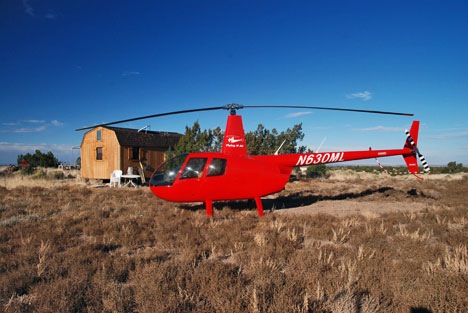In Texas, anything is possible.
This morning, I did a quick search of the NTSB reports to get some info about an R22 crash in Skull Valley, AZ that happened over the weekend. One of my Twitter friends, @heligypsy, had DMed me on Twitter, asking if I knew the people involved. I didn’t, but I know the terrain. A high density altitude photo mission in an R22 is never a good idea, and I had a sneaking suspicion that the details would confirm this. Again.
While my search for information about that accident came up empty — too new to be in the records — it did turn up another interesting helicopter accident, CEN09LA201, which occurred in Texas. The first paragraph of the preliminary accident report sounded downright weird:
On or about May 15, 2007, at an unknown (possibly, 1300) central daylight time, a Robinson R22, N456PH, piloted by an non-certificated pilot, was substantially damaged when it struck a pole and impacted terrain either during takeoff or landing at a ranch in Midland, Texas. Visual meteorological conditions are assumed to have prevailed at the time of the accident. The personal flight was being conducted under the provisions of Title 14 Code of Federal Regulations (CFR) Part 91 without a flight plan. The pilot reportedly was uninjured. The flight originated at an unknown time and location.
How many NTSB reports have you read that include the words unknown (two times), possibly, assumed, and reportedly?
Turns out, the accident did not occur on the report date of March 10, 2009. It occurred nearly two years earlier:
On March 10, 2009, FAA’s Flight Standards District Office in Lubbock, Texas, was contacted by a local rancher, who said there was a 2-year-old wrecked helicopter on his property, and he wanted permission to dispose of it. Unaware of such an accident, an FAA inspector went to the site. The inspector confirmed that an accident had occurred and had never been reported. The rancher said he became aware of the accident around July 2007.
The report continues with some aircraft history that sums up a few facts:
- The helicopter owner had been taking flight lessons in Tucson.
- The helicopter owner had planned to use the helicopter to give sightseeing flights in Mexico.
- The helicopter owner had put exactly 1.9 hours on the helicopter after transporting it by truck from Arizona, where its last maintenance work was done, to Texas.
- The crash had occurred when a main rotor blade struck a pole while the helicopter was either taking off or landing between two buildings on a Texas ranch.
Here’s the final line from the report:
According to FAA, the pilot’s name does not appear in their pilot database. According to the rancher, after the accident the pilot, who was uninjured, extricated himself and walked away.
Now if he was really smart, he would have come back with a flatbed truck and carted away the evidence of his stupidity.
But then what would I blog about today?

 N630ML at Howard Mesa, November 2008
N630ML at Howard Mesa, November 2008